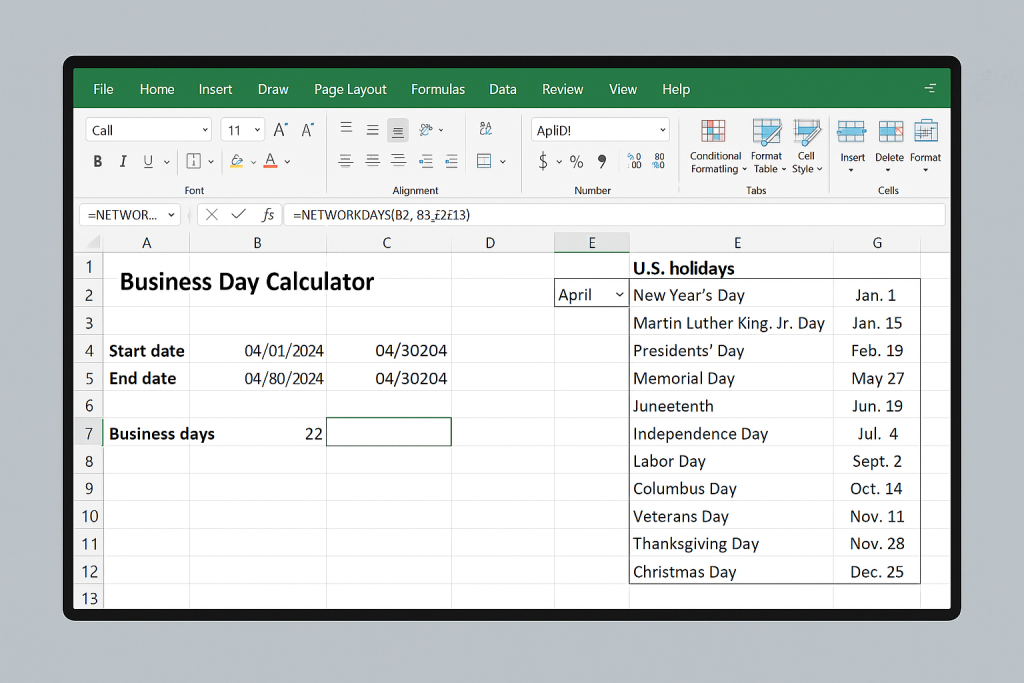Understanding Business Days: Definition and Importance
Knowing the exact number of business days in a month is crucial for managing payroll, planning project timelines, and organizing business operations. But what exactly counts as a business day, and why is it so important to get this calculation right?

Business days are typically defined as the days when most businesses are operational, usually Monday through Friday, excluding weekends and official public holidays. This standard is vital for everyone from HR professionals to project managers who need to schedule tasks, process payments, and meet deadlines.
Accurate business day calculations help companies remain compliant, ensure timely project deliveries, and streamline communication with clients and partners. Whether you’re an entrepreneur, freelancer, or an employee, understanding the number of business days in each month is essential for effective planning.
How to Calculate Business Days in a Month
Step-by-Step Calculation Method
Calculating the number of business days in a month may seem straightforward, but it requires attention to detail. Here’s a simple approach:
- Identify total days in the month: Start with the total number of days in your target month (28–31).
- Subtract weekends: Count and exclude all Saturdays and Sundays.
- Remove public holidays: Subtract official holidays that fall on weekdays.

This method provides a clear and reliable way to determine business days, but local holiday observances and variances in work culture (like industries operating on Saturdays) should always be considered.
Business Days by Month: Example Overview
Here’s a general example for a standard year in the United States, assuming no holidays:
- January: 31 days, 21–23 business days
- February: 28 days (29 in leap years), 20 business days
- March: 31 days, 23 business days
- April: 30 days, 22 business days
- May: 31 days, 23 business days
- June: 30 days, 22 business days
- July: 31 days, 23 business days
- August: 31 days, 23 business days
- September: 30 days, 22 business days
- October: 31 days, 23 business days
- November: 30 days, 22 business days
- December: 31 days, 22–23 business days
These figures are approximate, as official holidays can reduce the total number of business days in any given month.
Factors Influencing the Number of Business Days
Weekends and Leap Years
The distribution of weekends across months will affect the total business days. For instance, if the first of the month falls on a Saturday or Sunday, this might result in more or fewer business days compared to months that start on a weekday. Leap years only affect February, increasing its business days by one if the leap day falls on a weekday.
National and Local Holidays
Holidays are a primary reason the number of business days fluctuates month-to-month. In the United States, federal holidays such as New Year’s Day, Independence Day, Thanksgiving, and Christmas must be subtracted if they land on business days. Many countries and regions have their own specific holidays, so always check your local calendar.
Tip: Some businesses may also observe “floating holidays” or additional company days off—factor these into your calculation each month.
Industry or Company-Specific Schedules
Some businesses, particularly in manufacturing or retail, may operate on Saturdays or even Sundays. In these cases, the definition of a business day differs, and calculations need to reflect the company’s actual work schedule.
Why Knowing the Number of Business Days Matters
Payroll and Employee Scheduling
Payroll departments rely on business day counts to process salaries, manage hourly wages, and allocate paid leave. Inconsistent calculations can lead to payroll errors, employee dissatisfaction, and even legal disputes.
Employers also use business days to structure work shifts and ensure that coverage meets company needs, especially during months with more or fewer business days due to holidays.
Project Planning and Deadlines
Project managers and teams need to know the number of business days in a month to set realistic deadlines and allocate resources efficiently. This knowledge ensures that the workload is distributed fairly and that project milestones are met without last-minute rushes.
External deadlines—such as tax filings, contract deliveries, or compliance submissions—usually reference business days, making accurate counts essential for legal and operational compliance.
Financial Forecasting and Invoicing
Many companies align their financial forecasts, invoicing cycles, and budget planning with the actual number of working days available. If you overestimate or underestimate available business days, it can lead to missed targets or resource shortages.
How Holidays Affect Business Days by Country
United States
The U.S. observes ten federal holidays, and when these fall on a weekday, they reduce the month’s business days. For example, if July 4th (Independence Day) lands on a Tuesday, July will have one less business day. Additionally, some states and companies may add regional or floating holidays.

United Kingdom
The U.K. recognizes eight standard public holidays, but these vary in date and can fall on weekends, in which case a “substitute day” is observed. This often results in a slightly different pattern of business days compared to the U.S.
Other Countries
Countries such as China, India, and those in the Middle East have distinct public holiday calendars and may include religious or national observances that significantly affect the number of business days each month. For example, during Ramadan or Golden Week, there may be several consecutive non-working days.
Tools and Tips for Calculating Business Days Accurately
Online Calculators and Spreadsheets
Several online tools and calculators can help you quickly determine the number of business days in a specific month, taking into account local holidays and weekends. Microsoft Excel, for instance, offers the NETWORKDAYS and NETWORKDAYS.INTL functions, which allow you to automate these calculations with customizable parameters for holidays.

- Excel: =NETWORKDAYS(start_date, end_date, [holidays])
- Google Sheets: =NETWORKDAYS(start_date, end_date, [holidays])
- Online calculators: Many free resources are available—just ensure they reflect your country or industry holidays.
Practical Tips for Business Day Calculations
- Always check a current calendar for weekends and holidays.
- Update your holiday list annually to account for changes and floating dates.
- When in doubt, consult your HR or payroll department for the official business calendar used by your company.
- For international businesses, confirm local working days before scheduling meetings or setting deadlines.
Frequently Asked Questions (FAQs)
Are business days the same as working days?
In most cases, “business days” and “working days” are interchangeable, both referring to days when work is typically performed. However, some organizations or countries define them differently, so always confirm the meaning in your specific context.
How do leap years affect business days?
Leap years add an extra day to February. If February 29th falls on a weekday, it adds one business day for that year. If it falls on a weekend, there’s no change to the business day count.
Can I automate business day calculations?
Yes! Using spreadsheet functions like NETWORKDAYS or specialized software can greatly speed up and simplify your business day calculations, especially for larger organizations with complex holiday calendars.
Conclusion: Mastering Business Day Calculation for Success
Understanding and accurately calculating how many business days are in a month is vital for payroll, project management, scheduling, and overall business efficiency. By following the methods and tips outlined above, you can ensure that your business operations run smoothly, deadlines are realistic, and your staff remains satisfied.
For the most precise results, always use updated calendars, consider local holidays, and leverage technology to automate your calculations. Being thorough and proactive about business day planning will help you stay ahead in today’s competitive marketplace.


